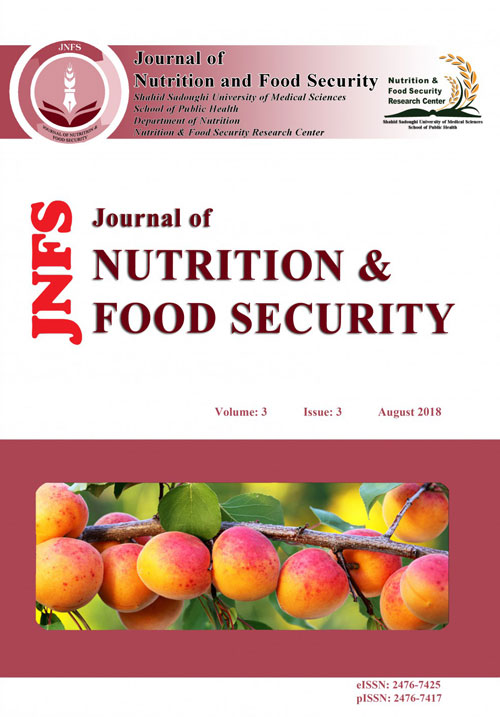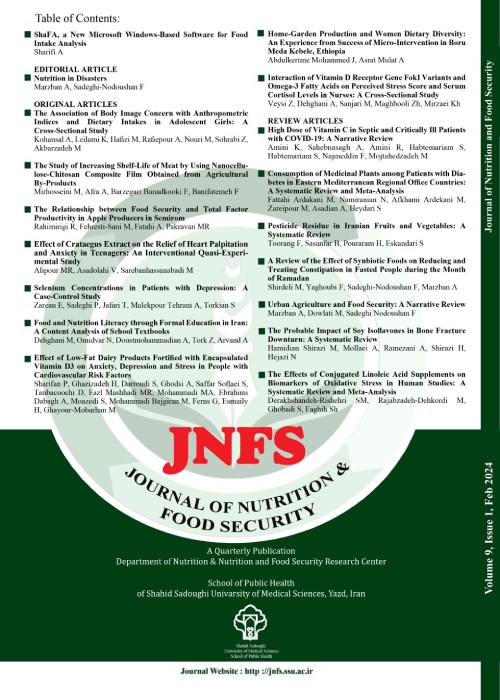فهرست مطالب

Journal of Nutrition and Food Security
Volume:3 Issue: 3, Aug 2018
- تاریخ انتشار: 1397/06/03
- تعداد عناوین: 8
-
Pages 113-115This study aimed to examine the relationship between food security, health and economic growth. These three components together form the vertices of a triangle. How much does food security strategies in a country bring more health to its people? Is the healthy population richer? What is the impact of health on income, and to what extent are income variation among countries characterized by variation in health? Does better nutritional status contribute to faster economic growth?Keywords: Pregnant women, Nutrition, Nutrition recommendation
-
Pages 116-122BackgroundDue to the importance of nutrition during pregnancy and its role in future generation's health, the study tried to determine dietary diversity and its relationship with newborn's anthropometric indices at birth.MethodsIn this cross-sectional study, 400 pregnant women (28-40 weeks of pregnancy) whom were referred to the health centers in Zahedan were studied in 2016. To assess the usual dietary intake, food frequency questionnaire and the 24-hour recall were used. Dietary diversity was calculated based on the score 8 of food groups using food pyramid of Food and Agriculture Department, and Kant method. Newborn's anthropometric indices were measured by the standard and analyzed by using descriptive statistics and analytical tests.ResultsThe mean (± Standard deviation) of the total score of dietary diversity was 2.60 ± 0.73 and the highest diversity was seen in the dairy group (0.45 ± 0.19) and the lowest diversity of food was observed in grains group (0.20 ± 0.10). There was a significant difference between various groups of birth weight at the score of dietary diversity and it was significantly increased by rising family's incomes. The linear regression analysis has shown that the variables including; weight at the beginning of pregnancy, a variety of dairy products, vegetables and total dietary diversity could be considered for predicting birth weight.ConclusionThe study has shown that there was a significant correlation between the score of dietary diversity and newborn's anthropometric indices at birthKeywords: Birth weight, Dietary diversity, Pregnancy
-
Pages 123-129BackgroundGiven that abdominal obesity increases the risk of affecting metabolic and cardiovascular diseases, this study was conducted to determine the relationship between energy and macronutrient intake with women's abdominal obesity in Sabzevar.MethodsIn this study, 225 female nurses and medical staff in Vasee hospital of Sabzevar were selected. In order to assess the dietary intake, data were gathered by completing food frequency questionnaire (FFQ). Anthropometric indices including: height, weight, waist circumference, hip circumference of the samples was measured according to standard guideline and waist to hip circumference ratio (WHR) and body mass index (BMI) were calculated. The WHR > 0.8 was considered as abdominal obesity. The level of significance was (PResultsThe result showed that of the waist mean circumference was 80.73 ± 12.58 cm, hip circumference was 102.29 ± 11.57 cm and women's WHR was 0.87 ± 0.15. The mean of energy, fat, protein, carbohydrate and cholesterol intake in assessed women was more than the standard dietary intake. There was no significant relationship between abdominal obesity and energy and macronutrient intake.ConclusionsThis study showed that the incidence of female abdominal obesity is high and energy and macronutrient intake is recommended more than the standard. This problem emphasizes the necessity of converting dietary habits and pattern of worker women in order to enhance dietary status and reducing obesityKeywords: Abdominal obesity, Energy, Macronutrients, Women
-
Pages 130-138BackgroundConsidering the effectiveness of green tea and Melissa officinalis in reducing weight and blood pressure in past studies, this study aimed to compare the effects of green tea and Melissa officinalis on blood pressure and weight in welders.MethodsThis is a single-blind crossover clinical trial. Twenty welders from a workshop entered the study. Green tea and Melissa officinalis infusions (4 g/d) were provided 2 times a day for 4 weeks in random order with a 3-week washout. Measurements were performed at the beginning and the end of each intervention. The environmental pollution of the workshop was measured by the professional health engineer at the beginning.ResultsThe diet and black tea intake were not different during the interventions (P > 0.05). Physical activity was not different throughout the study, although the intensity of physical activity was higher in the Melissa officinalis period (12.31 ± 12.89 versus 60.00 ± 33.95 min/ week; P = 0.06). Weight, body mass index and diastolic blood pressure decreased during the period of Melissa officinalis consumption and there was a slight increase during the green tea period (P > 0.05).ConclusionsIt is likely that one month of consumption of Melissa officinalis is as effective as green tea in changing weight and blood pressure, and therefore they can be a good alternative to each otherKeywords: Blood pressure, Green tea, Melissa officinalis, Weight, Welder
-
Pages 139-148BackgroundChicken fillets contain essential amino acids besides many minerals and vitamins, which are necessary for maintaining life and promoting growth. Moreover, it is low in calories and cholesterol; therefore, it can be used for feeding infants, young children, and some patients.MethodsChicken fillets were initially coated by dipping in different concentrations of chitosan (1.0%, 1.5%, and 2.0%), and then the shelf life of coated samples was investigated under refrigeration storage (4 ± 1 °C) for 15 days. The control (uncoated) and coated samples were analyzed periodically for bacteriological, pH value, and sensory characteristics.ResultsThe sensory evaluation results correlated with the microbial analyses. Chitosan-coated samples achieved a shelf-life extension of 12 days at chilled storage temperature (4 ± 1 °C) whereas the non-coated samples had a shelf life of 3 days at the same storage temperature. There were no significant organoleptic changes within the chitosan-coated samples (P > 0.05). The pH values of all coated samples were significantly lower than the control group (PConclusionThe present study established that application of chitosan coating on chicken fillets could have a potential for preserving the microbiological quality and enhancing sensory attributes during chilled storage.Keywords: Chicken fillets, Chilled storage, Chitosan coating, Microbiological quality, Shelf life
-
Pages 149-156BackgroundKnowledge regarding distribution and determinants of household food insecurity focusing on vulnerable groups is utmost important for ensuring food security, which is every nation prime agenda. This study was conducted to determine the prevalence and determinants of household food insecurity among the tribal population of Purulia, West Bengal.MethodsA cross-sectional study was carried out among 134 tribal households covering a total 632 population selected from 3 administrative divisions of Purulia district by two-stage random sampling. Information collected on selected demographic and socio-economic profile of the households including utilization of public distribution system (PDS) by house-to-house interview. A Bengali version of validated household food security scale-short form was used as a tool for data collection. Furthermore, the anthropometry was carried out among the children aged 6-59 months.ResultsThe results showed that the prevalence of household food insecurity was 35.8% in the study area. Households with lower socio-economic status, kutcha houses, low income related to the family members, holding of below poverty line (BPL), and ration card were significantly associated with the household food insecurity. Prevalence of under-weight and stunting among 6-59 months children were found significantly more among food insecure households.ConclusionsIn-spite of several efforts, household food insecurity was quite prevalent especially among vulnerable poor households. Therefore, it shows that food security along with poverty reduction activities are required to be increased at the household levelKeywords: Determinants, Household food insecurity, India, Tribal population
-
Pages 157-166BackgroundAccording to traditional beliefs, chamomile products have anti-depression effect. The aim of this study was to investigate the effects of chamomile tea on glycemic control, depression status and lipid profiles in type 2 diabetes (T2D) with depression.MethodsThis randomized clinical trial was carried out on 74 depressed patients with T2D. Participants were randomly divided into two 37-people groups, chamomile tea (CG) and black tea group (BG). The CG received 3 cups of chamomile tea daily and the BG received 3 cups of black tea daily half an hour after meals for 12 weeks. To examine the status of depression, Beck II test was utilized. Anthropometric measurements, 24-h dietary recalls, glycosylated hemoglobin A1c (HbA1c) and blood lipids profile were measured at the baseline and at the end of the intervention.ResultsThe HbA1c mean was significantly reduced in CG after the intervention, when compared with BG (7.15 ± 1.23% vs. 7.98 ± 1.76%, P = 0.02). In the same vein, the mean changes in CG and BG were -0.74 ± 1.29 and 0.04 ± 1.07 (P = 0.006), respectively. No significant changes were observed in mean of serum lipids within and between groups. The Beck score also showed a significant reduction in the CG after the intervention (PConclusionsThe results of this study demonstrated that drinking three cups of chamomile tea daily for 12 weeks by T2D suffering from depression lead to improve glycemic control and depression state. Therefore, drinking this kind of tea by these patients is recommendedKeywords: Chamomile, Depression, Diabetes mellitus, Serum lipids
-
Pages 167-174BackgroundThis review aimed to express the exact role of nutrition components including carbohydrates, fats, proteins and other dietary factors such as probiotics, micro and macro nutrients and the life pattern including body weight in the development of dental caries.MethodsCarbohydrate, fat, protein, vitamin and mineral, probiotics and lifestyle, along with dental caries, cavitation and or dental cavitation were searched in PubMed, SCOPUS and Web of sciences databases.ResultsIn this study, 28 articles were included; since cariogenic effects of fermentable carbohydrate containing foods and the amount and frequency of consuming such foods have been known, recommendations to replace sugar with starchy foods to avoid dental caries are of questionable value; vitamins and minerals are important in controlling the occurrence of oral inflammation and enhancement of immunity; fat containing foods that play a role as bacterial adherence could be induced by hydrophobic interactions which get facilitated by a lipid-rich environment. Although there are differences in the salivary lipid content of caries-sustainable and caries-resistant individuals, a meta-analysis showed that there was a moderate association between dental caries and the salivary lipid content. Proteins also are known as cariostatic agents; however, their effects might differ according to their types of amino-acids. Probiotics might play beneficial roles as antagonistic agents on acidogenic bacteria that will reduce dental decay. Sedentary lifestyles among children associated with an increased consumption of unhealthy diet rich in sugar can increase the risk of both weight gain and dental caries.ConclusionsSpecific programs focusing on health promotion and education strategies are needed.Keywords: Life style, Nutrition, Nutrients, Dental caries


